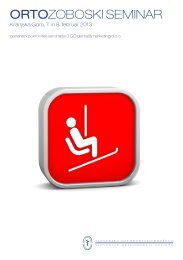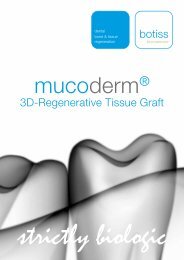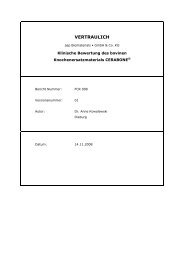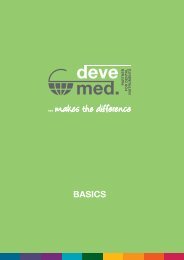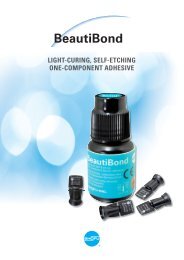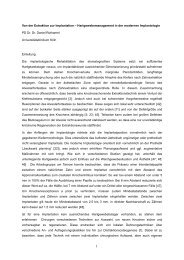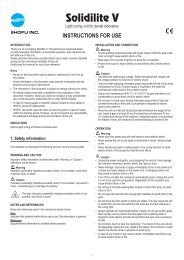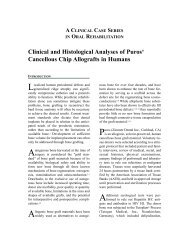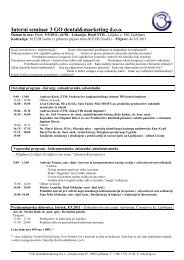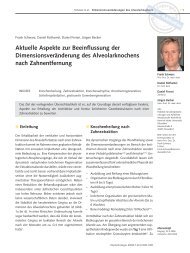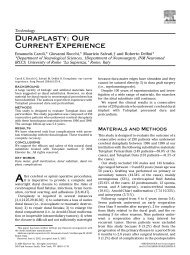Enamel Bonding of Self-etch and Phosphoric Acid-etch Orthodontic ...
Enamel Bonding of Self-etch and Phosphoric Acid-etch Orthodontic ...
Enamel Bonding of Self-etch and Phosphoric Acid-etch Orthodontic ...
- No tags were found...
You also want an ePaper? Increase the reach of your titles
YUMPU automatically turns print PDFs into web optimized ePapers that Google loves.
KITAYAMA et al. Dental Materials Journal 261 : 135143, 2007 135<strong>Enamel</strong> <strong>Bonding</strong> <strong>of</strong> <strong>Self</strong>-<strong>etch</strong> <strong>and</strong> <strong>Phosphoric</strong> <strong>Acid</strong>-<strong>etch</strong> <strong>Orthodontic</strong> Adhesive SystemsShuzo KITAYAMA 1 , Toru NIKAIDO 1 , Masaomi IKEDA 1 , Richard M. FOXTON 2 <strong>and</strong> Junji TAGAMI 1,31Cariology <strong>and</strong> Operative Dentistry, Department <strong>of</strong> Restorative Science, Graduate School, Tokyo Medical <strong>and</strong> DentalUniversity, 1-5-45, Yushima, Bunkyo-ku, Tokyo 113-8549, Japan2Department <strong>of</strong> Conservative Dentistry, Floor 25, King’s College London Dental Institute at Guy’s, King’s <strong>and</strong> St. Thomas’Hospitals, Guy’s Hospital, London Bridge, London SE1-9RT, UK3Center <strong>of</strong> Excellence (COE) Program for Frontier Research on Molecular Destruction <strong>and</strong> Reconstruction <strong>of</strong> Tooth <strong>and</strong> Bonein Tokyo Medical <strong>and</strong> Dental University, 1-5-45, Yushima, Bunkyo-ku, Tokyo 113-8549, JapanCorresponding author, Shuzo KITAYAMA; E-mail: nuevo_centro@yahoo.co.jpReceived August 31, 2006 /Accepted October 30, 2006This study was conducted to examine the shear bond strengths <strong>of</strong> orthodontic brackets to ground enamel with two self<strong>etch</strong>ingadhesives (Beauty Ortho Bond <strong>and</strong> Transbond XT) <strong>and</strong> two phosphoric acid-<strong>etch</strong>ing adhesives (Kurasper F <strong>and</strong>Orthomite Superbond). After the bonded specimens were stored in water at 37for 24 hours, they were subjected to thermalcycling (TC) at 0 <strong>and</strong> 5000 cycles. Then, shear bond test was performed at a crosshead speed <strong>of</strong> 1 mm/min. Results indicatedthat the self-<strong>etch</strong>ing adhesives did not significantly differ in bond strength before <strong>and</strong> after TC (p>0.05), while thephosphoric acid-<strong>etch</strong>ing adhesives showed a significant reduction after TC (p
136<strong>Enamel</strong> bonding <strong>of</strong> orthodontic adhesive systemsTable 1Materials used in this study.Material Manufacturer Batch No. Composition InstructionsBeauty OrthoBond (BO)Transbond XT(TB)Kurasper F(KF)OrthomiteSuperbond (OS)Sh<strong>of</strong>u, Kyoto,Japan3M Unitek,Monrovia,California, USAKuraray Medical,Tokyo, JapanSun Medical,Moriyama, JapanPrimer A: 11031301 Water, Solvent 3s applyPrimer B: 03041101Paste: 02040901Transbond Plusself-<strong>etch</strong>ing primer: 204758Paste: 5MU<strong>Phosphoric</strong> acid monomer,Solvent, DyesTEGDMA, S-PRG filler,Bis-GMAMethacrylated phosphoricacid esters, Aminobenzoate, CamphorquinoneBis-GMA, TEGDMA,Silane-treated quartz,Amorphous silica,CamphorquinoneGently air-dry20s light-cure3s applyGently air-dry20s light-cureK-<strong>etch</strong>ant: 00353B 37<strong>Phosphoric</strong> acid 40s applyF-bond: 00036BPaste: 00026FTEGDMA, 2-HEMA,Bis-GMA, Methylmethacrylate-methacryloylfluoride copolymer,Sodium fluoride, Silanatedsilica filler, InitiatorsTEGMA, Bis-GMA,Silanated glass filler,Initiators20s washStrongly air-dry40s light-cureRed Activator: LE4 65<strong>Phosphoric</strong> acid 30s applyPowder: KX2 PMMA 20s washLiquid: LF3 MMA, 4-META Strongly air-dryCatalyst: LE61 Tri-n-butylborane Chemical-cureTEGDMA: triethylene glycol dimethacrylate; PRG: pre-reacted glass ionomer; Bis-GMA: bisphenol A diglycidyl etherdimethacrylate; HEMA: 2-hydroxyethyl methacrylate; MMA: methyl methacrylate; PMMA: polymethyl methacrylate;4-META: 4-methacryloyloxyethyl trimellitate anhydrideadhesive paste includes S-PRG (surface pre-reactedglass ionomer) filler particles, which are formed byan acid-base reaction between fluoroaluminosilicateglass <strong>and</strong> a polyalkenoic acid in the presence <strong>of</strong>water 12) . S-PRG fillers can release <strong>and</strong> recharge fluorideions 12) .Transbond XT is composed <strong>of</strong> a fluoride-freelight-cured adhesive system. Transbond Plus self<strong>etch</strong>ingprimer was used as a conditioner, which containsmethacrylated phosphoric acid esters.Kurasper F is composed <strong>of</strong> a phosphoric acid<strong>etch</strong>ant <strong>and</strong> a fluoride-releasing light-cured adhesivesystem in which sodium fluoride is the source <strong>of</strong>fluoride ion release.Orthomite Superbond is composed <strong>of</strong> a phosphoricacid <strong>etch</strong>ant <strong>and</strong> a fluoride-free chemically curedadhesive system which consists <strong>of</strong> PMMA powder, aliquid component (MMA <strong>and</strong> 4-META), <strong>and</strong> a chemicalinitiator (tri-n-butylborane) 13,14) .Specimen preparationEighty freshly extracted bovine incisors free <strong>of</strong> obviousdefects were stored frozen prior to use. Theroots <strong>of</strong> the teeth were cut <strong>of</strong>f, leaving the crowns,which were embedded in a chemically cured acrylicresin (Unifast Trad, GC, Tokyo, Japan) in an acrylictube to allow for st<strong>and</strong>ardized <strong>and</strong> secure placementduring testing. The facial enamel surface was parallelto <strong>and</strong> about 1 mm above the cylinder rim. Then,the exposed enamel was flattened with 600-grit siliconecarbide paper under copious water to provide anarea for bonding. The enamel surfaces were thencleaned ultrasonically in distilled water. Afterwhich, the specimens were r<strong>and</strong>omly divided into
KITAYAMA et al. 137eight groups.<strong>Orthodontic</strong> metal brackets (One Piece Bracket,Kanno, Nagareyama, Japan) with a bonding area <strong>of</strong>16.96 mm 2 were bonded to the enamel surface accordingto the manufacturers’ instructions (Table 1).All bonding procedures were performed by thesame operator. Excess adhesive was carefully removed,<strong>and</strong> the BO, TB, <strong>and</strong> KF specimens werelight-cured with a visible light curing unit (Optilux500, Sybron Kerr Corp., USA), while the specimens <strong>of</strong>OS were chemically cured at room temperature. ForBO <strong>and</strong> TB, the specimens were light-cured for 20seconds (10 seconds from the mesial edge <strong>and</strong> 10 secondsfrom the distal edge <strong>of</strong> bracket). For KF, thespecimens were light-cured for 40 seconds (20 secondsfrom mesial <strong>and</strong> 20 seconds from distal).Shear bond testPrepared specimens were left at room temperaturefor 30 minutes, <strong>and</strong> then stored in one <strong>of</strong> the twoconditions as follows: deionized water at 37for 24hours (TC-0) or deionized water at 37for 24 hoursfollowed by thermal cycling <strong>of</strong> 5000 times (5-55,dwell time <strong>of</strong> 30 seconds each) (TC-5000). Thermalcycling is a well-known in vitro durability test,which accelerates water penetration through the interfacebetween the adhesive <strong>and</strong> enamel. Bishara etal. 15)evaluated the bonding durability <strong>of</strong> orthodonticbrackets using thermal cycling <strong>of</strong> 500 times.Sirirungrojying et al. 10)also evaluated bonding durabilityusing thermal cycling <strong>of</strong> 2000 <strong>and</strong> 5000 times.In this study, thermal cycling was determined at5000 times.Shear bond test was performed for each specimenusing an ISO st<strong>and</strong>ard jig 16)in the same manner asdescribed by Ikeda et al. 17) . A universal testing machine(AG 500B, Shimadzu, Kyoto, Japan) was usedfor the shear bond test at a crosshead speed <strong>of</strong> 1mm/min as shown in Fig. 1. Each tooth was orientedso that its facial surface was parallel to the direction<strong>of</strong> force during the shear bond test. Theforce was directly applied to the bracket-tooth interface.Load at bracket failure was recorded by a personalcomputer connected to the testing machine.Shear bond strength value was calculated in MPa bydividing the force by the area <strong>of</strong> the bracket base.Failure mode analysisAfter debonding, the teeth <strong>and</strong> brackets were examinedunder 10 magnification with an optical microscope(OME-GWHIO, Olympus Co., Tokyo, Japan)<strong>and</strong> scored according to the criteria <strong>of</strong> the adhesiveremnant index (ARI) 18)as follows: 0No adhesive lefton tooth; 1Less than half <strong>of</strong> the adhesive left ontooth; 2 More than half <strong>of</strong> the adhesive left ontooth; 3All the adhesive left on the tooth, with distinctimpression <strong>of</strong> the bracket mesh.SEM observationThe ground enamel surface <strong>and</strong> enamel surfaces conditionedwith each adhesive system were observedwith a SEM. The enamel surface was ground with600-grit silicone carbide paper under copious water<strong>and</strong> ultrasonically cleaned in distilled water. For BO<strong>and</strong> TB, the self-<strong>etch</strong>ing primer <strong>of</strong> each system wasapplied to the ground enamel surface according tothe manufacturers’ instructions, gently air-blown,rinsed with acetone for 30 seconds, <strong>and</strong> then rinsedwith distilled water for 30 seconds followed by gentleair-drying. For KF <strong>and</strong> OS, the enamel surface was<strong>etch</strong>ed with phosphoric acid, rinsed with water for 30seconds, <strong>and</strong> gently air-dried.To observe the debonded surface <strong>of</strong> the specimens,representative debonded specimens were selectedfrom each group. All specimens were goldsputter-coated before examination with a SEM (JSM5310LV, JOEL, Tokyo, Japan).Fig. 1Schematic drawing <strong>of</strong> shear bond strength measurement.Statistical analysisThe number <strong>of</strong> specimens per group for shear bondtesting was 10. Shear bond strengths were analyzedby two-way analysis <strong>of</strong> variance (ANOVA) using theStatistical Package for Medical Science (SPSS Ver.11for Windows) for statistical procedures. The factorsanalyzed were material <strong>and</strong> storage condition.Following this, Tukey’s HSD test was performed.ARI scores <strong>of</strong> the mode <strong>of</strong> failure were analyzedusing Steel-Dwass nonparametric multiple comparisontest by Tukey’s procedure. The statistical calculations<strong>of</strong> mode <strong>of</strong> failure were performed using astatistical s<strong>of</strong>tware, KyPlot (Version 3.0 for
138<strong>Enamel</strong> bonding <strong>of</strong> orthodontic adhesive systemsWindows, Keyence Incorporated, Tokyo, Japan).Significance for all statistical tests was predeterminedat a 95confidence level.Table 2Shear bond strengths to enamel (MPa).TC-0TC-5000RESULTSShear bond strengthThe shear bond strengths <strong>of</strong> the four orthodontic adhesivesto enamel are summarized in Table 2.Statistical significance <strong>of</strong> the bond strengths toenamel is shown in Table 3. Two-way ANOVA revealedthat bond strength was influenced by bothmaterial (F=4.688, p=0.005) <strong>and</strong> storage condition(F=21.720, p=0.0001). There was also a significant interactionbetween the independent variables, material<strong>and</strong> storage condition (F=3.272, p=0.026).In the TC-0 groups, there were no significantdifferences between BO <strong>and</strong> phosphoric acid-<strong>etch</strong>ingadhesive systems (KF <strong>and</strong> OS), while the bondstrength <strong>of</strong> TB was significantly lower than those <strong>of</strong>BO 20.3 4.7 18.8 4.1TB 17.6 4.0 16.4 3.3KF 23.9 3.8 17.5 4.9OS 24.9 3.2 17.7 2.8n=10, MeanSD TC-0: Not thermocycledTC-5000: Thermocycledphosphoric acid-<strong>etch</strong>ing adhesive systems (KF <strong>and</strong>OS). There were no significant differences betweenBO <strong>and</strong> TB, <strong>and</strong> between KF <strong>and</strong> OS, respectively(p>0.05).In the cases <strong>of</strong> BO <strong>and</strong> TB, there were no significantdifferences in bond strength between TC-0 <strong>and</strong>TC-5000 (p>0.05). However, the bond strengths <strong>of</strong> KFTable 3Summary <strong>of</strong> the statistical analysis <strong>of</strong> the bond strengths to enamel using ANOVA supplemented withTukey’s HSD test.BO TB KF OSAdhesive TC TC-0 TC-5000 TC-0 TC-5000 TC-0 TC-5000 TC-0 TC-5000BOTC-0TC-5000n.s.TBKFOSTC-0 n.s. n.s.TC-5000 n.s. n.s. n.s.TC-0 n.s. n.s.* *TC-5000 n.s. n.s. n.s. n.s.* * *TC-0 n.s. n.s.TC-5000 n.s. n.s. n.s. n.s. n.s.****Table 4Frequency distribution <strong>of</strong> adhesive remnant index (ARI) scores.TC-0ARI scoresTC-5000ARI scores0 1 2 3 0 1 2 3BO 3 7 0 0 2 5 1 2TB 6 3 1 0 4 5 1 0KF 8 2 0 0 7 3 0 0OS 1 2 2 5 2 1 2 5ARI indicates adhesive remnant index; 0: No adhesive left on the tooth; 1: Less than half <strong>of</strong> the adhesive left on thetooth; 2: More than half <strong>of</strong> the adhesive left on the tooth; 3: All the adhesive left on the tooth with distinct impression<strong>of</strong> the bracket mesh.
KITAYAMA et al. 139abFig. 2SEM photograph <strong>of</strong> enamel surface groundwith 600-grit silicone carbide paper (2000).Smear layer <strong>and</strong> scratch lines were observed.<strong>and</strong> OS significantly decreased after 5000 times <strong>of</strong>thermal cycling (p0.05).Modes <strong>of</strong> failureThe modes <strong>of</strong> failure according to the ARI index aresummarized in Table 4. For each adhesive, no significantdifferences were observed between the TC-0<strong>and</strong> TC-5000 groups (p>0.05). However, there weresignificant differences in the mode <strong>of</strong> failure betweenKF (TC-0) <strong>and</strong> OS (TC-0), <strong>and</strong> between KF (TC-5000)<strong>and</strong> OS (TC-0) (p
140<strong>Enamel</strong> bonding <strong>of</strong> orthodontic adhesive systemsabenamel surface was selectively <strong>etch</strong>ed <strong>and</strong> easily identified.Micro-irregularity <strong>of</strong> the hydroxyapatitecrystals was apparent.Typical fracture surfaces on the enamel sideafter shear bond testing are depicted in Fig. 4.Partial adhesive failure occurred predominantly inthe BO, TB <strong>and</strong> KF groups, in which remnants <strong>of</strong>the adhesives remained on the enamel surface (Figs.4(a) to (c)). In the OS group, failures mainly occurredat the interface between the bracket <strong>and</strong> theadhesive in both TC-0 <strong>and</strong> TC-5000 conditions (Fig.4(d)). Distinct impressions <strong>of</strong> the bracket mesh wereobserved.Fig. 4 SEM photographs <strong>of</strong> typicalfracture surfaces on the enamelside after shear bond testing.a: Beauty Orthobond (TC-0) (2000); b: Transbond XT (TC-0)(2000); c: Kurasper F (TC-0)(2000); d: Orthomite Superbond(TC-0) (50). Partial adhesivefailure was observed, <strong>and</strong> remnants<strong>of</strong> adhesive remained onthe enamel surface (a, b, c).Distinct impression <strong>of</strong> thebracket mesh was observed (d).Mode <strong>of</strong> fracture tendency <strong>of</strong>each adhesive was not differentbetween the TC-0 <strong>and</strong> TC-5000groups.cdDISCUSSIONDirect bonding <strong>of</strong> orthodontic brackets using theacid-<strong>etch</strong> technique has become a common techniquein the orthodontic field. <strong>Phosphoric</strong> acid <strong>etch</strong>ing producesa roughened enamel surface by dissolving calciumcomponents <strong>and</strong> forming enamel resin tags.Although enamel <strong>etch</strong>ing technique is a useful <strong>and</strong>accepted procedure for bonding orthodontic brackets,there is a need to maintain clinically useful bondstrengths while minimizing the amount <strong>of</strong> enamelloss.Recent studies in operative dentistry have suggestedthat self-<strong>etch</strong>ing primers with lower decalcifyingability are less effective than phosphoric acid<strong>etch</strong>ing when used to bond to ground enamel or intactenamel 19) . Previously, Bishara et al. 11) found thatthe shear bond strength <strong>of</strong> orthodontic brackets afterPrompt L-Pop self-<strong>etch</strong>ing primer treatment was significantlylower than that after phosphoric acid <strong>etch</strong>ingwith TB. Yamada et al. 20) also found that theshear bond strength after SE Bond self-<strong>etch</strong>ingprimer (Kurary Medical) treatment was significantlylower than that after phosphoric acid <strong>etch</strong>ing withKF. Similarly, the present study demonstrated thatthe shear bond strengths <strong>of</strong> brackets bonded with theself-<strong>etch</strong>ing adhesive systems (BO <strong>and</strong> TB) were lowerthan those bonded with phosphoric acid-<strong>etch</strong>ing adhesivesystems (KF <strong>and</strong> OS) in the control groups.However, a bond strength <strong>of</strong> approximately 17 MPawas maintained after thermal cycling in the self<strong>etch</strong>ingadhesive groups, while the bond strength significantlydecreased after thermal stress in thephosphoric acid-<strong>etch</strong>ing groups. It should be pointedout that Martin <strong>and</strong> Garcia-Godoy 21)commented thathigh shear bond strength in orthodontics is not necessarilya beneficial property <strong>of</strong> an orthodontic adhesive,because enamel can be lost during the debondingprocedure as well as during the removal <strong>of</strong> residualresin. Bishara et al. 22) reported that a shear bondstrength <strong>of</strong> 7 MPa to the enamel was clinically acceptablefor bonding to the enamel surface in orthodontictreatment. Data obtained in this study thus
KITAYAMA et al. 141suggested that all the adhesive systems evaluatedwere acceptable for routine clinical use.The effects <strong>of</strong> thermal changes on the bondstrength <strong>of</strong> resin-based materials to hard dental tissues,as well as on their mechanical properties (i.e.,fracture toughness, elastic modulus), have been welldocumented 23,24) . Thermal cycling stresses the bondbetween resin <strong>and</strong> tooth substance <strong>and</strong> might affectbond strength 25) . Christensen 26) commented that impressivein vitro bond strengths were transient whensubjected to temperature changes in the mouth.In the case <strong>of</strong> self-<strong>etch</strong>ing adhesive systems, theacidic monomers in the self-<strong>etch</strong>ing primers are responsiblefor both <strong>etch</strong>ing <strong>and</strong> bonding. As such, thedepth <strong>of</strong> demineralized enamel corresponds to thedepth <strong>of</strong> penetration <strong>of</strong> the adhesive to be polymerized.This mechanism thus circumvents problems associatedwith insufficient penetration as well asimproves the quality <strong>of</strong> hybridization 27-29) , thereby ensuingan excellent mechanical lock.<strong>Phosphoric</strong> acid <strong>etch</strong>ing creates resin tags formechanical retention between enamel <strong>and</strong> resin 30) .However, the resin may not completely infiltrate<strong>etch</strong>ed enamel 31) . A region <strong>of</strong> unprotected enamelprisms might be susceptible to hydrolytic degradationafter thermal cycling. In addition, water diffusioninto the bonded interface between adhesive <strong>and</strong>tooth surface was found to cause the resin to swell<strong>and</strong> become plasticized 32) , as well as reduce enamelhardness due to loss <strong>of</strong> surface calcium 33) .Basically, there are two opinions on the remainingadhesive following bracket debonding. One opinionlargely favors bracket-adhesive interface failurewith the adhesive resin left mainly on the enamelsurface 5,34) , when a heavy-filled resin is used to bondorthodontic attachments. The microporosities createdby <strong>etch</strong>ing are filled with the resin <strong>and</strong> provide mechanicalretention. The second opinion favors failureat the enamel-adhesive resin interface, because thereis less adhesive left to remove from the enamel surfaceafter debonding 34) . Martin <strong>and</strong> Garcia-Godoy 21)suggested that a weaker adhesive with a lowerstrength value might be preferable so as to increasefailure rate at the enamel-adhesive resin interface.In this way, minimal clean-up would be needed withreduced likelihood <strong>of</strong> damage to the enamel.The predominant mode <strong>of</strong> bracket failure for BO,TB, <strong>and</strong> KF was at the enamel-resin interface withless than 50<strong>of</strong> the adhesive on the enamel surface.In the cases <strong>of</strong> BO <strong>and</strong> TB, scratch lines with 600-grit silicone carbide paper were observed afterdebonding, which indicated that the self-<strong>etch</strong>ing adhesivesystems did not damage the enamel surface duringdebonding.As for OS, the predominant mode <strong>of</strong> bracket failurewas at the bracket-adhesive interface with morethan 50<strong>of</strong> the adhesive on the enamel surface. OSis MMA-based, the mechanical properties <strong>of</strong> whichare weaker than the light-cured adhesive resins 35,36) .Hotta et al. 37) reported that 4-MET, a hydrolysisproduct <strong>of</strong> 4-META, promoted effective diffusion <strong>of</strong>monomers into enamel. SEM observations <strong>of</strong> theconditioned enamel surfaces revealed that the self<strong>etch</strong>ingprimers produced less enamel dissolutioncompared with phosphoric acid <strong>etch</strong>ing. Moreover,the morphological appearances <strong>of</strong> the enamel surfacewere different between KF <strong>and</strong> OS, which was probablydue to the different concentrations <strong>of</strong> phosphoricacid in the <strong>etch</strong>ants. The 37phosphoric acid <strong>of</strong> K-<strong>etch</strong>ant in KF was more aggressive than the 65solution<strong>of</strong> Red Activator in OS 31) .Decalcification is a common side effect <strong>of</strong> fixedappliance orthodontic treatment 38) . On this note, orthodontictreatment with multibonded appliancesposes a significant caries risk 6,39) . To counter thisproblem, fluoride-releasing composites for bondingbrackets have attracted considerable attention <strong>and</strong>garnered much interest. This is because they mayinhibit the decalcification <strong>of</strong> enamel around thebrackets by delivering fluoride to the affectedenvironment 40,41) . Furthermore, the remineralizationcapability <strong>and</strong> antibacterial property <strong>of</strong> fluoride mayhelp eliminate the risk <strong>of</strong> dental caries 42) . BO containsS-PRG filler for the release <strong>and</strong> uptake <strong>of</strong> fluorideions, <strong>and</strong> might thus prevent demineralizationbut facilitate remineralization <strong>of</strong> the surroundingenamel 6) .<strong>Orthodontic</strong> bracket bonding is performed on intactenamel. The intact enamel surface ishypermineralized <strong>and</strong> contains more fluoride thanground enamel. Prismless layer on enamel surface 43)is less conducive to bonding by conventional acid gelconditioning 44) <strong>and</strong> self-<strong>etch</strong>ing primer application 45) .Kanemura et al. 45)reported that bond strength wassignificantly reduced when self-<strong>etch</strong>ing systems werebonded to intact enamel. Similarly, Senawongse etal. 46)reported that self-<strong>etch</strong>ing adhesive systems exhibitedsignificantly lower bond strengths than thephosphoric acid-<strong>etch</strong>ing adhesive systems on intactenamel. However, no statistically significant differenceswere found between self-<strong>etch</strong>ing adhesive systems<strong>and</strong> phosphoric acid-<strong>etch</strong>ing adhesive systems toground enamel. Furthermore, bond strengths <strong>of</strong> self<strong>etch</strong>ingadhesive systems to ground enamel were significantlyhigher than those to unground enamel,whereas phosphoric acid <strong>etch</strong>ing systems showed nosuch significant differences between intact <strong>and</strong>ground enamel. Based on the results obtained todate, further research is indeed needed to clarifywhether self-<strong>etch</strong>ing primer adhesive systems couldprovide sufficient bond strength to intact humanenamel.
142<strong>Enamel</strong> bonding <strong>of</strong> orthodontic adhesive systemsCONCLUSIONS<strong>Self</strong>-<strong>etch</strong>ing adhesives, Beauty Ortho Bond <strong>and</strong>Transbond XT, showed more stable bond strengthsto ground enamel after thermal cycling than thephosphoric acid-<strong>etch</strong>ing adhesives, Kurasper F <strong>and</strong>Orthomite Superbond. In addition, with self-<strong>etch</strong>ingadhesives, problems concerning the decalcification <strong>of</strong><strong>and</strong> damage to the enamel surface were eliminated.ACKNOWLEDGEMENTSThis work was supported by a grant for the Center<strong>of</strong> Excellence Program for Frontier Research onMolecular Destruction <strong>and</strong> Reconstruction <strong>of</strong> Tooth<strong>and</strong> Bone at Tokyo Medical <strong>and</strong> Dental University.REFERENCES1) Buonocore MG. A simple method <strong>of</strong> increasing theadhesion <strong>of</strong> acrylic filling materials to enamel surfaces.J Dent Res 1955; 34:849-853.2) Zarrinnia K, Eid NM, Kehoe MJ. The effect <strong>of</strong> differentdebonding techniques on the enamel surface: anin vitro qualitative study. Am J Orthod Dent<strong>of</strong>acialOrthop 1995; 108:284-293.3) Thanos CE, Munholl<strong>and</strong> T, Caputo AA. Adhesion <strong>of</strong>mesh base direct bonding brackets. Am J Orthod1979; 75:421-430.4) Gorelick L. <strong>Bonding</strong> metal brackets with a selfpolymerizingsealant-composite: a 12-month assessment.Am J Orthod Dent<strong>of</strong>acial Orthop 1977; 71:542-553.5) Pr<strong>of</strong>fit W. Contemporary orthodontics, CV MosbyCo, St Louis, 1986, pp.282-295.6) O’Reilly MM, Featherstone JD. Demineralization <strong>and</strong>remineralization around orthodontic appliances: an invivo study. Am J Orthod Dent<strong>of</strong>acial Orthop 1987;92:33-40.7) Chigira H, Koike T, Hasegawa T, Itoh K, WakumotoS, Hayakawa T. Effect <strong>of</strong> the self <strong>etch</strong>ing dentinprimers on the bonding efficacy <strong>of</strong> a dentin adhesive.Dent Mater J 1989; 8:86-92.8) Han L, Cruz E, Fukushima M, Okamoto A, Okiji T.An ultrastructural analysis <strong>of</strong> the prototype singlestepadhesive applied on enamel <strong>and</strong> dentin surfaces.Dent Mater J 2004; 23:321-328.9) Cacciafesta V, Sfondrini MF, De Angelis M, ScribanteA, Klersy C. Effect <strong>of</strong> water <strong>and</strong> saliva contaminationon shear bond strength <strong>of</strong> brackets bonded withconventional, hydrophilic, <strong>and</strong> self-<strong>etch</strong>ing primers.Am J Orthod Dent<strong>of</strong>acial Orthop 2003; 123:633-640.10) Sirirungrojying S, Hayakawa T, Saito K, Meguro D,Nemoto K, Kasai K. <strong>Bonding</strong> durability between orthodonticbrackets <strong>and</strong> human enamel treated withmegabond self-<strong>etch</strong>ing primer using 4-META/MMA-TBB resin cement. Dent Mater J 2004; 23:251-257.11) Bishara SE, Von Wald L, Laffoon JF, Warren JJ.Effect <strong>of</strong> a self-<strong>etch</strong> primer/adhesive on the shearbond strength <strong>of</strong> orthodontic brackets. Am J OrthodDent<strong>of</strong>acial Orthop 2001; 119:621-624.12) Ikemura K, Tay FR, Kouro Y, Endo T, YoshiyamaM, Miyai K, Pashley DH. Optimizing filler contentin an adhesive system containing pre-reacted glassionomerfillers. Dent Mater 2003; 19:137-146.13) Kameyama A, Ihara S, Amagai T, Miake Y, KawadaE, Oda Y, Yanagisawa T, Hirai Y. Adhesion <strong>of</strong> 4-META/MMA-TBB resin to heated dentin: effects <strong>of</strong>pre-treatments with FeCl3 <strong>and</strong>/or HEMA. DentMater J 2003; 22:1-9.14) Hirabayashi C. Studies on MMA-TBB resin II. Theeffect <strong>of</strong> dual use <strong>of</strong> TBB <strong>and</strong> other initiators on polymerization<strong>of</strong> PMMA/MMA resin. Dent Mater J2003; 22:48-55.15) Bishara SE, Ajlouni R, Laffoon JF. Effect <strong>of</strong> thermocyclingon the shear bond strength <strong>of</strong> a cyanoacrylateorthodontic adhesive. Am J Orthod Dent<strong>of</strong>acialOrthop 2003; 123:21-24.16) Noguchi H, Nakano M, Kumasaka A, Etchu Y.Evaluation <strong>of</strong> Japanese dental adhesives. Dent Eng1982; 60:16-27.17) Ikeda M, Nikaido T, Foxton RM, Tagami J. Shearbond strengths <strong>of</strong> indirect resin composites to hybridceramic. Dent Mater J 2005; 24:238-243.18) Artun J, Bergl<strong>and</strong> S. Clinical trials with crystalgrowth conditioning as an alternative to acid-<strong>etch</strong>enamel pretreatment. Am J Orthod 1984; 85:333-340.19) Pashley DH, Tay FR. Aggressiveness <strong>of</strong> contemporaryself-<strong>etch</strong>ing adhesives. Part II: Etching effectson unground enamel. Dent Mater 2001; 17:430-444.20) Yamada R, Hayakawa T, Kasai K. Effect <strong>of</strong> usingself-<strong>etch</strong>ing primer for bonding orthodontic brackets.Angle Orthod 2002; 72:558-564.21) Martin S, Garcia-Godoy F. Shear bond strength <strong>of</strong>orthodontic brackets cemented with a zinc oxidepolyvinylcement. Am J Orthod Dent<strong>of</strong>acial Orthop1994; 106:615-620.22) Bishara SE, Gordan VV, Von Wald L, Jakobsen JR.Shear bond strength <strong>of</strong> composite, glass ionomer, <strong>and</strong>acidic primer adhesive systems. Am J OrthodDent<strong>of</strong>acial Orthop 1999; 115:24-28.23) Miyazaki M, Sato M, Onose H. Durability <strong>of</strong> enamelbond strength <strong>of</strong> simplified bonding systems. OperDent 2000; 25:75-80.24) Price RB, Der<strong>and</strong> T, Andreou P, Murphy D. The effect<strong>of</strong> two configuration factors, time, <strong>and</strong> thermalcycling on resin to dentin bond strengths.Biomaterials 2003; 24:1013-1021.25) Nikaido T, Kunzelmann KH, Chen H, Ogata M,Harada N, Yamaguchi S, Cox CF, Hickel R, TagamiJ. Evaluation <strong>of</strong> thermal cycling <strong>and</strong> mechanicalloading on bond strength <strong>of</strong> a self-<strong>etch</strong>ing primersystem to dentin. Dent Mater 2002; 18:269-275.26) Christensen GJ. Has tooth structure been replaced?J Am Dent Assoc 2002; 133:103-105.27) Weerasinghe DS, Nikaido T, Wettasinghe KA,Abayakoon JB, Tagami J. Micro-shear bondstrength <strong>and</strong> morphological analysis <strong>of</strong> a self-<strong>etch</strong>ingprimer adhesive system to fluorosed enamel. J Dent2005; 33:419-426.28) Nakabayashi N, Pashley DH. Hybridization <strong>of</strong> dentalhard tissue, Quintessence Publishing Co, Tokyo, 1998,pp.6-7.29) Gordan VV, Vargas MA, Cobb DS. Evaluation <strong>of</strong> adhesivesystems using acidic primers. Am J Dent1997; 10:219-223.30) Soetopo, Beech DR, Hardwick JL. Mechanism <strong>of</strong> adhesion<strong>of</strong> polymers to acid-<strong>etch</strong>ed enamel. Effect <strong>of</strong>acid concentration <strong>and</strong> washing on bond strength. J
KITAYAMA et al. 143Oral Rehabil 1978; 5:69-80.31) Shinchi MJ, Soma K, Nakabayashi N. The effect <strong>of</strong>phosphoric acid concentration on resin tag length <strong>and</strong>bond strength <strong>of</strong> a photo-cured resin to acid-<strong>etch</strong>edenamel. Dent Mater 2000; 16:324-329.32) Soderholm KJ. Correlation <strong>of</strong> in vivo <strong>and</strong> in vitroperformance <strong>of</strong> adhesive restorative materials: a report<strong>of</strong> the ASC MD156 Task Group on Test Methodsfor the Adhesion <strong>of</strong> Restorative Materials. DentMater 1991; 7:74-83.33) Muhlemann HR. Storage medium <strong>and</strong> enamel hardness.Helv Odontol Acta 1964; 8:112-117.34) Bishara SE, Ajlouni R, Laffoon JF. Comparison <strong>of</strong>the shear bond strength <strong>of</strong> 2 self-<strong>etch</strong> primer/adhesivesystems. Am J Orthod Dent<strong>of</strong>acial Orthop 2004;125:348-350.35) Burrow MF, Tagami J, Negishi T, Nikaido T, HosodaH. Early tensile bond strengths <strong>of</strong> several enamel<strong>and</strong> dentin bonding systems. J Dent Res 1994; 73:522-528.36) Kitasako Y, Burrow MF, Nikaido T, Tagami J. Longtermtensile bond durability <strong>of</strong> two different 4-METAcontaining resin cements to dentin. Dent Mater 2002;18:276-280.37) Hotta K, Mogi M, Miura F, Nakabayashi N. Effect<strong>of</strong> 4-MET on bond strength <strong>and</strong> penetration <strong>of</strong> monomersinto enamel. Dent Mater 1992; 8:173-175.38) Millett DT, Nunn JH, Welburry RR, Gordon PH.Decalcification in relation to brackets bonded withglass ionomer cement or a resin adhesive. AngleOrthod 1999; 69:65-70.39) Ogaard B. Prevalence <strong>of</strong> white spot lesions in 19-year-olds: a study on untreated <strong>and</strong> orthodonticallytreated persons 5 years after treatment. Am JOrthod Dent<strong>of</strong>acial Orthop 1989; 96:423-427.40) Mitchell L. An investigation into the effect <strong>of</strong> a fluoridereleasing adhesive on the prevalence <strong>of</strong> enamelsurface changes associated with directly bonded orthodonticattachments. Br J Orthod 1992; 19:207-214.41) Cildir SK, S<strong>and</strong>alli N. Fluoride release/uptake <strong>of</strong>glass-ionomer cements <strong>and</strong> polyacid-modified compositeresins. Dent Mater J 2005; 24:92-97.42) Imazato S. Antibacterial properties <strong>of</strong> resin composites<strong>and</strong> dentin bonding systems. Dent Mater 2003;19:449-457.43) Whittaker DK. Structural variations in the surfacezone <strong>of</strong> human tooth enamel observed by scanningelectron microscopy. Arch Oral Biol 1982; 27:383-392.44) Nathanson D, Bodkin JL, Evans JR. SEM <strong>of</strong> <strong>etch</strong>ingpatterns in surface <strong>and</strong> subsurface enamel. JPedodont 1982; 7:11-17.45) Kanemura N, Sano H, Tagami J. Tensile bondstrength to <strong>and</strong> SEM evaluation <strong>of</strong> ground <strong>and</strong> intactenamel surfaces. J Dent 1999; 27:523-530.46) Senawongse P, Sattabanasuk V, Shimada Y, OtsukiM, Tagami J. Bond strengths <strong>of</strong> current adhesivesystems on intact <strong>and</strong> ground enamel. J EsthetRestor Dent 2004; 16:107-115.



